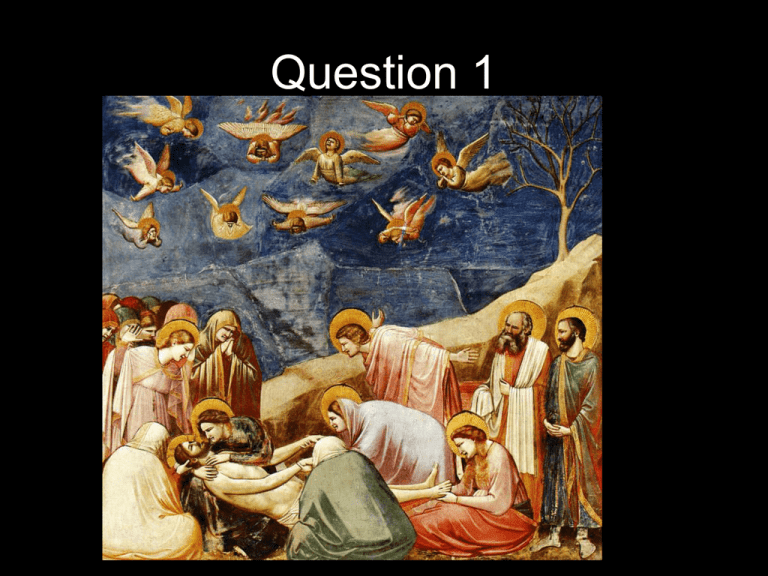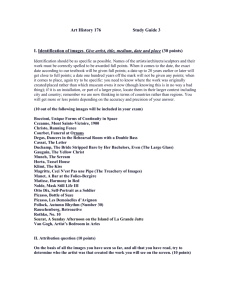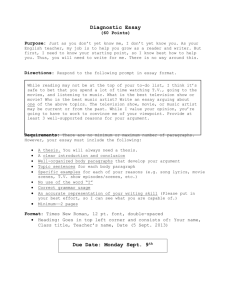QQQ Short Answer and Essay 94 to 98 Combined
advertisement

Question 1 Question 2 Question 3 Question 4 Question 5 Question 6 Question 7 Question 8 – No image • ESSAY – Major changes in architectural form and function are often made possible by new construction methods or new materials. • Discuss such changes in two different art historical periods, at least one before 1800. • Use specific buildings as examples to support your discussion. (30 minutes) Question 9 – No image • ESSAY – Many works of art, such as paintings, sculptures and monuments, have celebrated famous individuals. For example, writers, actors, military or religious leaders, political figures and philosophers. • Identify two such works, each from a different art historical period, and compare the ways in which each work celebrates the individual. (30 minutes) Question 10 Question 11 Question 12 Question 13 Question 14 Question 15 Question 16 Question 17 – No image • ESSAY – Buildings can relate to their sites in various ways. • Choosing two buildings, discuss one building in terms of the physical relationship to its site and the other in terms of its symbolic or historical relationship to its site. • Identify each building by name and period. (30 minutes) Question 18 – No image • ESSAY – Select two paintings, one before 1800 and one after 1800, in which the artist has depicted the daily life of her or his own time as the subject. • Identify each work by artist and title and compare the ways in which the artists depict the subject matter. (30 minutes) Question 19 Question 20 Question 21 Question 22 Question 23 Question 24 Question 25 Question 26 – No image • ESSAY – Many artists have been interested in creating the illusion of movement on two-dimensional surfaces. • Identify by artist and title TWO such twodimensional works, each from a different century, in which the artist is concerned with implying movement. • Discuss the techniques that each artist used to depict movement. (30 minutes) Question 27 – No image • ESSAY – Choose two sculptural groups created after 500 BC that are free-standing (sculpture in the round) and that include two or more figures. • Identify each work as specifically as possible. • Discuss the ways in which each sculptor treated the relationship among the figures within the group, the relationship of the group to its surrounding space, and the relationship of the group to the viewer. (30 minutes) Question 28 Question 29 Question 30 Question 31 Question 32 Question 33 Question 34 Question 35 – No image • ESSAY – In depicting significant events from their own times, artists interpret those events in a variety of ways. • Identify by title and artist (if historically known) two depictions, in any medium, of events from the artist’s own time – one depiction before 1500, the other after 1500. • For each work, discuss the visual and stylistic means used by the artist to convey a social or political interpretation of the event. (30 minutes) Question 36 – No image • ESSAY – Choose and identify TWO PostImpressionist paintings by different artists. • Discuss the ways in which each artist used and modified the basic concepts of Impressionism. Question 37 Question 38 Question 39 Question 40 Question 41 Question 42 Question 43 Question 44 – No image • ESSAY – Many cultures designate spaces or create structures for religious devotion. • Choose two specific examples, each from a different culture. AT LEAST ONE CULTURE MUST BE NON-EUROPEAN OR NONEUROPEAN BASED. • Identify your examples and their cultures. Discuss the ways in which your examples create places appropriate for religious devotion in each culture. • Consider (if applicable) plan, orientation, site, structure, ornamentation, etc. (30 minutes) Question 45 – No image • ESSAY – Select two portrait paintings (NOT SELF-PORTRAITS), each of a single individual by different artists, and from different periods. • Identify each work by title and artist. • How does each work reflect the stylistic tendency of the artist’s own time? • Compare and contrast how each artist portrays the person’s individuality. (30 minutes) Question 46 Question 47 Question 48 Question 49 Question 50 Question 51 Question 52 Question 53 – No image • ESSAY – Choose two specific images of power and authority, each produced in a different culture. At least one must come from a non-European-based tradition. • How does each work of art convey that particular culture’s notion of what constitutes power and authority? (30 minutes) Question 54 – No image • ESSAY – Many artists radically transform actual observation and experience in order to express their unique artistic vision. • Select TWO works, each by a different artist. • Discuss ways in which each artist has radically transformed observed reality in order to achieve a personal vision. (30 minutes) Question 55 Question 56 Question 57 Question 58 Question 59 Question 60 Question 61 Question 62 – No image • ESSAY – Virtually all of the world’s cultures have defined sacred spaces for religious purposes. The design and appearance of these spaces vary greatly. • Fully identify two specific sacred spaces, at least one of which must be from beyond the European tradition. • For each choice, discuss the relationship between the appearance of the space and its religious function. (30 minutes) Question 63 – No image • ESSAY – Representations of the human body vary considerably in different periods and cultures. • Fully identify two specific representations of the human figure, each from a different period or culture. • Discuss how each work reflects the cultural values of its time period or the place where it was made. (30 minutes)



